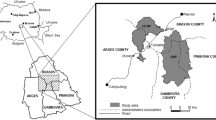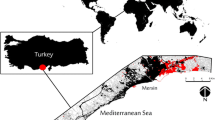Abstract
Landscape is a dynamic phenomenon that almost continuously changes. The overall change of a landscape is the result of complex and interacting natural and spontaneous processes and planned actions by man. However, numerous activities by a large number of individuals are not concerted and contribute to the autonomous evolution of the landscape in a similar way as natural processes do. There is a well-established need to detect land use and ecological change so that appropriate policies for the regional sustainable development can be developed. Landscape change detection is considered to be effectively repeated surveillance and needs especially strict protocols to identify landscape change. This paper developed a series of technical frameworks on landscape detection based on Landsat Thematic Mapper (TM) Data. Through human-machine interactive interpretation, the interpretation precision was 92.00% in 1986 and 89.73% in 2000. Based on the interpretation results of TM images and taking Yulin prefecture as a case study area, the area of main landscape types was summarized respectively in 1986 and 2000. The landscape pattern changes in Yulin could be divided into ten types.
Similar content being viewed by others
References
Allen S Hope, Douglas A Stow, 1993. An analysis of tree mortality in southern California using high spatial resolution remotely sensed spectral radiances: a climatic change scenario.Landscape and Urban Planning, 24 (1–4): 87–94.
Anthony Gar-On Yeh, Li Xia, 1999. Economic development and agricultural land loss in the Pearl River Delta, China.Habitat International, 23(3): 373–390.
Antrop M, 1998. Landscape change: plan or chaos?Landscape and Urban Planning, 41: 155–161.
Brandt J J E, Bunce R G H, Howard D Cet al., 2002. General principles of monitoring land cover change based on two case studies in Britain and Denmark.Landscape and Urban Planning, 62: 37–51.
Bunce R G H, Heal O W, 1984. Landscape evaluation and the impact of changing land-use on the rural environment: the problem and an approach. In: Roberts R D, Roberts T M (eds.), Planning and Ecology. London: Chapman & Hall, 164–188.
Cai Yunlong, 2001. A study on land use/cover change: the need for a new integrated approach.Geographical Research, 20(6): 645–652. (in Chinese)
Deng Xiangzheng, Liu Jiyuan, Zhuang Dafanget al., 2002. Modeling the relationship of land use change and some geophysical indicators for the interlock area of farming and pasturing in China.Journal of Geographical Sciences, 12(4): 397–404.
Forman R T T, Godron M, 1986. Landscape Ecology. New York: John Wiley & Sons.
Fu Bojie, Chen Liding, Ma Keming, 1999. The effect of land use change on the regional environment in Yangjuangou Catchment in the Loess Plateau of China.Acta Geographica Sinica, 54(3): 241–246. (in Chinese)
Harms W B, Knol W C, Lankhorst J R, 2000. Modelling landscape changes in the Netherlands: the central city belt case study. In: Mander U E, Jongman R H G. (eds.), Landscape Perspectives of Land Use Changes. Southampton: WIT Press, 1–17.
Heather M Reese, Thomas M Lillesand, David E Nagelet al., 2002. Statewide land cover derived from multi-seasonal Landsat TM data: a retrospective of the WISCLAND project.Remote Sensing of Environment, 82: 224–237.
Kazunobu Nomura, Nobukazu Nakagoshi, 1999. Quantification of spatial structures in two landscape regions.Journal of Environmental Sciences, 12(2): 188–194.
Li Xiubin, 1996. A review of the international researches on land use/land cove change.Acta Geographica Sinica, 51(6): 553–558. (in Chinese)
Lillesand T M, 1992. Toward automation of statewide land cover mapping using remote sensing techniques. Environmental Remote Sensing Center/USDA-SCS Final Report, 125 pp.
Liu Jiyuan, Zhang Zengxiang, Zhuang Dafanget al., 2003. A study on the spatial-temporal dynamic changes of land-use and driving forces analyses of China in the 1990s.Geographical Research, 22(1): 1–12. (in Chinese)
Liu Jiyuan, Liu Mingliang, Zhuang Dafanget al., 2002. A primary study on spatial pattern of land-use change in China during 1990–2000.Science in China (Series D), 32(12): 1031–1040.
Oetter D R, Cohen W B, Berterretche Met al., 2001. Land cover mapping in an agricultural setting using multiseasonal Thematic Mapper data.Remote Sensing Environ., 76: 139–155.
Oneill R Vet al., 1988. Indices of landscape pattern.Landscape Ecology, 1: 153–162.
Paul M Treitz, Philip J Howarth, Roger C Sufflinget al., 1992. Application of detailed ground information to vegetation mapping with high spatial resolution digital imagery.Remote Sensing of Environment, 42(1): 65–82.
Qiu Yang, Zhang Jintun, Zheng Fengying, 2000. The kernel of landscape ecology: spatial and temporal heterogeneity in ecological systems.Chinese Journal of Ecology, 19(2): 42–49. (in Chinese)
Shi Peijun, Pan Yaozhong, Chen Jinet al., 1999. Land use/cover change and environmental security in Shenzhen region.Journal of Natural Resources, 14(4): 293–299. (in Chinese)
Yue Tianxiang, Liu Jiyuan, Sven Erik Jørgensenet al., 2003. Landscape change detection of the newly created wetland in Yellow River Delta.Ecological Modeling, 164: 21–31.
Turner B L II, Skole D, Sanderson Set al., 1995. Land-use and Land-cover Change. Science/Research Plan (=IGBP Report; 35/HDP Report7).
William L B, 1989. A review of models of landscape change.Lands. Ecol., 2: 111–133.
Yue Tianxiang, Haber W, Grossmann W Det al., 1998a. Discussion on models for species diversity and suggestion on a comprehensive model.Ecological Modeling, September, 1–15.
Yue Tianxiang, Liu Jiyuan, Jorgensen S Eet al., 2001. Changes of Holdridge life zone diversity in all of China over half a century.Ecological Modeling, 144: 153–162.
Author information
Authors and Affiliations
Corresponding author
Additional information
Foundation item: Sub-global project of UN Millennium Ecosystem Assessment (MA) program; Key project of international scientific and technological collaboration funded by the Ministry of Science and Technology of China, No. 2001DFDF0004
Author: Zhan Jinyan (1974–), Ph.D, specialized in cartography and GIS.
Rights and permissions
About this article
Cite this article
Zhan, J., Deng, X. & Yue, T. Landscape change detection in Yulin prefecture. J. Geogr. Sci. 14 (Suppl 1), 47–55 (2004). https://doi.org/10.1007/BF02873090
Received:
Accepted:
Issue Date:
DOI: https://doi.org/10.1007/BF02873090




